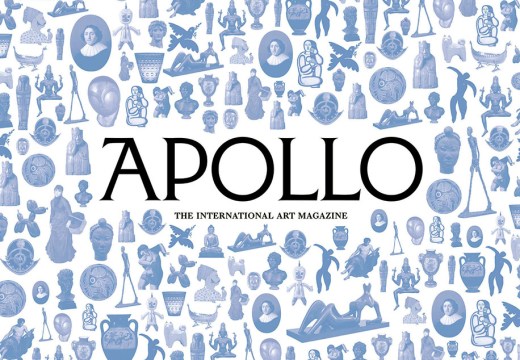We are pleased to present the shortlists for the Apollo Awards 2013 over the coming days, in advance of the release of our December issue. Every year, Apollo celebrates outstanding achievements in the art world, recognising the Book of the Year, Exhibition of the Year, Museum Opening of the Year, Acquisition of the Year and Personality of the Year. The winners and shortlisted candidates come from a 12-month period since late-October 2012 and have been chosen from nominations made by our editorial advisory panel.
The awards are intended to highlight the strength and diversity of the art world. Naturally, for every individual and institution noted here there will be others whose achievements also merit recognition. We welcome your comments and opinions below each shortlist.
We are extremely grateful to Deutsche Asset and Wealth Management for their sponsorship of the Apollo Awards 2013.
Book of the Year
Ranging from comprehensive catalogues to provocative new perspectives on the arts, the publications shortlisted for Apollo’s Book of the Year demonstrate the importance of scholarly research, and its wider public reach.
The Wallace Collection Catalogues: Gold Boxes
Charles Truman
Paul Holberton Publishing, £100
ISBN 9780900785948
Collected by Sir Richard Wallace and his father, the 4th Marquess of Hertford, the 99 gold boxes and objets de vertu in the Wallace Collection include superb enamel-painted snuff boxes created in France in the mid 18th century. Charles Truman’s beautifully photographed catalogue makes them visible in all their detail; his lucid text is a model of how art history can be pleasurable without compromising on learnedness. See Apollo, September.
Picasso and Truth: From Cubism to Guernica
T.J. Clark
Princeton University Press, £29.95
ISBN 9780691157412
A challenging but vastly rewarding study of Picasso’s work from the early Cubist experiments to the horrors of Guernica. T.J. Clark takes umbrage at biographical interpretations of the paintings, instead scrutinising them closely before setting his observations against passages from Wittgenstein and Nietzsche. Typical of Clark, the prose is rich with aperçus that ought to provide new ways of thinking about Picasso. See Apollo, July/August.
Medieval Modern: Art out of Time
Alexander Nagel
Thames & Hudson, £29.95
ISBN 9780500238974
This provocative study pits modernism and its aftermath against the artistic production of the Middle Ages, exploring neglected congruences between practices and attitudes of the two periods. Nagel reads Bauhaus in the context of medieval cathedrals; presses Picasso against Cimabue; examines relics next to readymades. All of which makes for a radical challenge to chronological art history and to longstanding notions of periodicity.
Ham House: 400 Years of Collecting and Patronage
Christopher Rowell (ed.)
Yale University Press, £75
ISBN 9780300185409
This grand volume, which will be reviewed fully in Apollo in January 2014, makes an outstanding contribution to our knowledge of one of the most important 17th-century houses in Europe. Its meticulous essays, by National Trust curators and a range of international experts, cover everything from court connections to cabinet-making and picture-framing, all accompanied by a wealth of illustrations and many new photographs.
Paris 1650–1900: Decorative Arts in the Rijksmuseum
Reinier Baarsen
Yale University Press, £175
ISBN 9780300191295
The Rijksmuseum may hold one of the world’s finest collections of French decorative arts, but until now it has been comparatively little known. This opulent book displays its most important pieces, focusing on the exquisite craftsmanship that defined Paris for more than two centuries – from Boulle marquetry to Lalique glassware. Fascinating on technique, as well as on the historical Dutch taste for French work. See Apollo, September.
The Letters of Paul Cézanne
Alex Danchev (ed.)
Thames & Hudson, £29.95
ISBN 9780500239087
Cézanne: A Life
Alex Danchev
Profile Books, £30
ISBN 9781846681653
These two books, one an enlightening biography, the other a new translation of the painter’s surviving 250 or so letters, amount to one substantial project and are exemplary pieces of accessible scholarship. Danchev recasts Cézanne as a cultural symbol; in his telling, the gruff peasant painter was in fact a ‘deeply cultured and deliberately uncivilised’ man, influential over writers and painters alike.
The James A. De Rothschild Bequest at Waddesdon Manor: Catalogue of Printed Books and Bookbindings (2 vols.)
Giles Barber
The Rothschild Foundation, £300
ISBN 9780954731083
With the publication of these two volumes, which focus on the late 17th- and 18th-century books collected by Baron Ferdinand de Rothschild, the great Waddesdon Catalogue series reaches completion. Here, the late Giles Barber’s painstaking descriptions of some 790 books provide a worthy culmination to one of the most ambitious scholarly enterprises of our time.
Winners will be announced in the December issue of Apollo.
Click here to subscribe














![Masterpiece [Re]discovery 2022. Photo: Ben Fisher Photography, courtesy of Masterpiece London](http://zephr.apollo-magazine.com/wp-content/uploads/2022/07/MPL2022_4263.jpg)
‘Like landscape, his objects seem to breathe’: Gordon Baldwin (1932–2025)